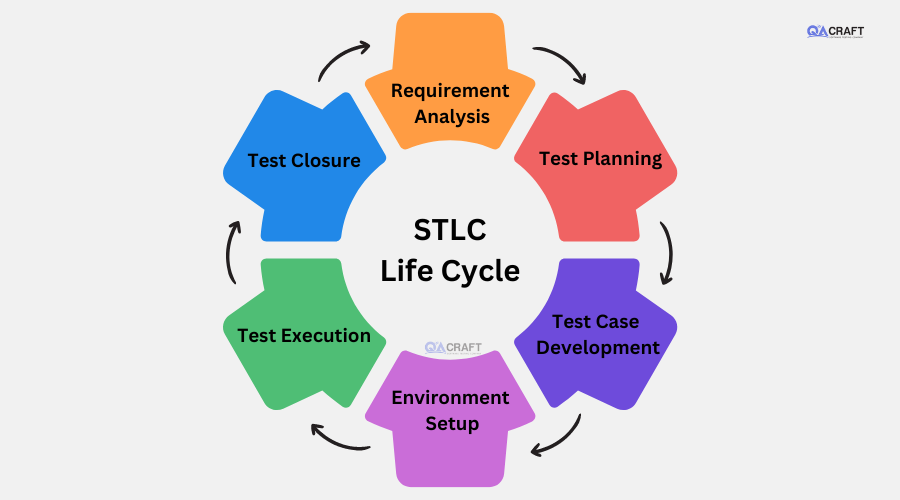26 Feb

What is the software testing life cycle?
The Software Testing Life Cycle is a set or group of activities carried out by the tester to test the software application in order to ensure that the application meets client requirements and is bug-free. It comprises a progression of tasks completed methodologically to help affirm your product item.
A reputable quality assurance service provider can assist your company in keeping software up to date and tested on a regular basis. We’ll look at the role of the software testing life cycle (STLC) and its phases in detail in this post. So let’s get started!
6 Phases of Software Testing Life Cycle (STLC):
There are various phases of STLC (Software Testing Life Cycle) which are as follows:
1) Requirement Analysis:
This is also known as Requirement Phase Testing. The basic standard of this stage is the BRS (Business Requirement Specification) document. In which the test group examines the prerequisites from a testing perspective to distinguish testable necessities and the QA group may associate with different partners to realize necessities in detail. Prerequisites could be either useful or non-practical. Automation practicality for the testing project is additionally done in this stage.
Activities Involve here are:- Distinguish the sorts of tests to be performed.
- Assemble insights concerning testing needs and core interests.
- Distinguish test climate subtleties where testing should be completed.
- Automation feasibility analysis.
- RTM
- Automation Feasibility Report.
- List of all testable necessities.
2) Test Planning:
Test Planning in STLC(Software Testing Life Cycle) is a stage where a Senior QA Lead/Manager decides the test plan technique alongside endeavors and quotes for the task. Along with, the assets, test environment, test restrictions, and testing plan are additionally decided. The Test Plan gets arranged and finished in a similar stage.
Activities Involve here are:- Arrangement of test plan/procedure archive for different kinds of testing.
- Test instrument determination.
- Test exertion assessment.
- Asset arranging and deciding jobs and duties.
- Preparing necessity.
- Test Strategy, Test Plan, and Test Effort assessment record.

3) Test Case Development:
The Test Case Development Phase includes the creation, check, and adjustment of experiments and test contents after the test plan is prepared. At first, the Test information is distinguished at that point made and discuss and afterward adjusted dependent on the preconditions. At that point, the QA group begins the improvement interaction of experiments for singular units.
Activities Involve here are:- Make test cases, and automation scripts (if applicable).
- Check and Discuss test cases and scripts.
- Make test data.
- Test cases, Test Scripts (if automation), and Test data.
Read also: How to Write Test Cases?
4) Environment Setup:
Test Environment Setup chooses the product and equipment conditions under which a work item is tried. It is one of the basic parts of the testing interaction and should be possible in corresponding with the Test Case Development Phase. Test groups may not be engaged with this action if the advancement group gives the test climate. The test group is needed to do an availability check (smoke testing) of the given climate.
Activities Involve here are:- Comprehend the necessary architecture, environment set-up, and plan equipment and programming prerequisites, etc.
- Arrangement test Environment and test information.
- Perform a smoke test on the build.
- Environment prepared with test information set up.
- Smoke Test Results.
5) Test Execution:
The test Execution Phase is done by the tester in which testing of the product assembly is done dependent on test plans and test case arranged. The cycle comprises test script execution, test script maintenance, and bug revealing. In the event that bugs are accounted for, at that point it is returned to the development team for improvement, and retesting will be performed.
Activities Involve here are:- Execute tests according to design.
- Record test results and log abandons for failed cases.
- Retest the Bug fixes.
- Track the imperfections to a conclusion.
- Test case execution report, Bug report.
6) Test Closure:
This is the last phase of the Software Testing Life Cycle which includes a few activities like test completion documents, a gathering of test completion matrices, and test outcomes. Testing colleagues meet, examine, and break down testing antiques to recognize systems that must be executed in the future, stepping through exercises from the current examination cycle. The thought is to eliminate measure bottlenecks for future test cycles.
Activities Involve here are:- Analyze cycle completion criteria based on Time, Test coverage, Cost, Software, Critical Business Objectives, and Quality.
- Get ready for test measurements dependent on the above boundaries.
- Prepare Test closure report.
- Test Closure Report, Test measurements.
Twisa works as a Software Tester at QACraft. She is a Computer Engineer with a degree and she has 5+ years of experience in the QA field(Manual as well as Automation Testing). As an automation tester, she has good knowledge about Automation testing of web-based applications using selenium Webdriver. In her free time, she loves to explore new technologies.
Related Post
Recent Posts
Categories
- Agile Testing
- Android App Testing
- Automation Testing
- Banking Domain Testing
- Beta Testing
- cloud testing
- Corporate Life
- cross browser testing
- Cypress Testing
- desktop testing
- Domain Testing
- E-commerce Website Testing
- E-learning App Testing
- Functional Testing
- Game Testing
- Healthcare Domain Testing
- Infographics
- Ios App Testing
- Jenkins
- JIRA
- Katalon
- Manual Testing
- Mobile App Testing
- monkey testing
- Performance Testing
- Salesforce Testing
- security testing
- Selenium
- Software Testing
- static testing
- Test Environments
- vdfv
- Web Application Testing
© Copyright 2024 QACraft Pvt. Ltd. All rights reserved.
Contact : +91 9157786796



Twisa Mistry